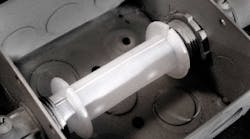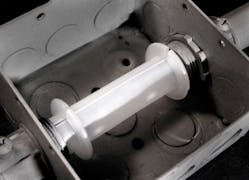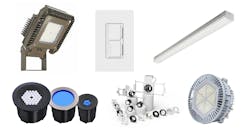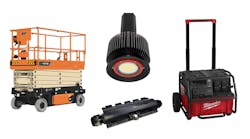This year's platinum winner in the 2010 Product of the Year competition comes from the conduit fittings category and proves that a simple device can prevail in a high-tech world. The Electrical Bypass is a patented, disposable device designed to provide electrical and communications contractors with an easier way to install conductors with multiple junction boxes when using conventional snake/wiring methods. In addition, the product also allows users to use a mouse and string setup to blow or vacuum a line from beginning to end of the conduit.
“When you're pushing a conventional metal snake through, typically you would have to stop at every box,” says Jim Sullivan, a master electrician, who, with his brother Frank, invented the device and co-founded The Electrical Bypass Co., Pittsfield, Mass. “When using the bypass, the wiring passes from one end to the other without getting stuck. That's particularly helpful if you're up in the air doing a row of 30 lights.”
The invention of the Electrical Bypass came about through necessity. As experienced electricians, the Sullivan brothers experienced the delays that came from pushing conductors through multiple junction boxes. “This was a problem we needed to solve,” says Sullivan. “Now, you can push a snake from one end to the other without having to stop at each box, and then it just tears out of the way at the end.”
To use the labor-saving device, install conduit and as many junction boxes as needed to complete the line. Then, simply insert The Electrical Bypass into junction boxes. “We suggest you put the bypasses in as you're installing the boxes, and then you don't need to get back to that box,” says Sullivan.
Tie on your wires and pull the wiring straight through to the desired box. You can then tear out the bypass at its perforated rip strips to access the wiring, and the job is complete.
In addition to saving time and labor, the use of the device eliminates the need for an additional scissor lift. “With the bypass in there, the snake doesn't get stuck, so you don't have to have someone else there to move the staging over to feed it through,” explains Sullivan, who estimates that a project with two conduit runs with 20 box installations can result in the savings of 4 hr or more. “A two-person job just became a one-person job in parts.”
The Electrical Bypass is manufactured in the United States and is available in various sizes (including ½ in., ¾ in., and 1 in.) and is packaged in bags of 20. “Really, it's just a simple product, but electricians always appreciate something that works,” says Sullivan.
For more information, visit www.electricalbypass.com/.




